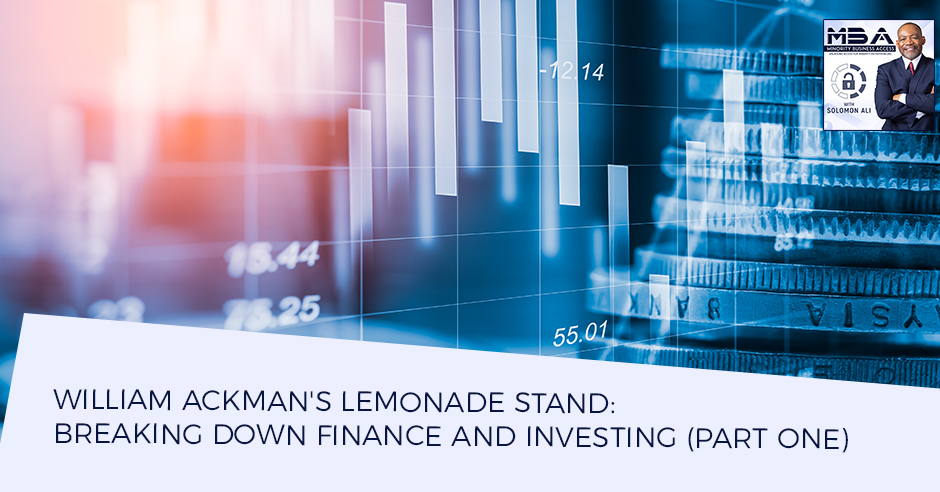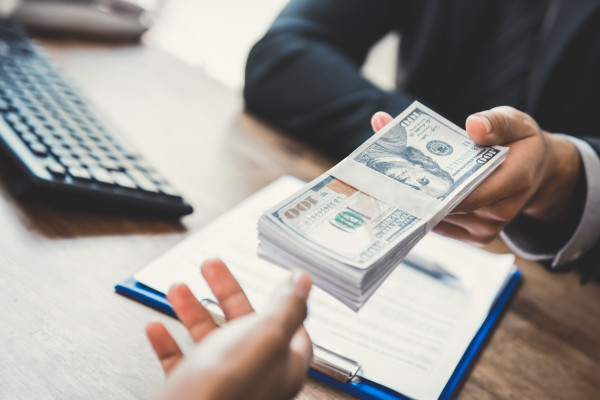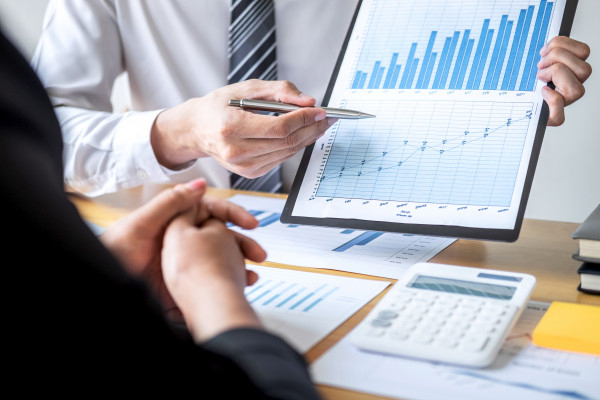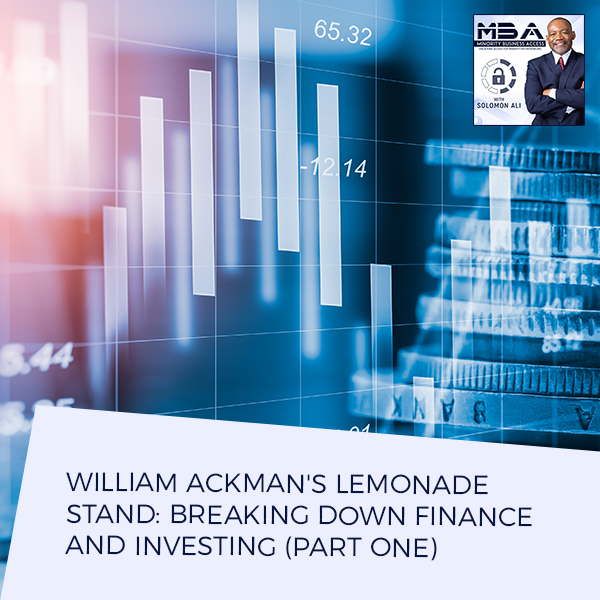
Everyone in the finance and investing world has probably heard about billionaire investor William Albert Ackman. Before becoming one of the top investors in the world, he learned the basics of investing in his early 20s. On today’s podcast, host Solomon Ali plays and breaks down one of Ackman’s most popular videos, where he talks about everything people need to know about finance and investing using a lemonade stand as an illustration.
—
Watch the episode here
Listen to the podcast here
William Ackman’s Lemonade Stand: Breaking Down Finance And Investing (Part One)
We’re going to do something a little different than we’ve done before. A friend of mine was on YouTube looking at a bunch of different videos and things of that nature. He said, “Solomon, do you know who William Ackman is?” I said, “Yes, I believe I’ve heard of William Ackman.” He does a lot of activist work. Activists being buying into companies like Carl Icahn. He sent me over the video. I looked at this video a few times and I said, “This is a good video.” What made it good to me is you could relate to it. He broke it down in such simple terms that you can understand it. You can relate to it, you get it. That’s important. He did a much better job than I could have ever done. They put a lot of thought into this video. What we’re going to do is we’re going to play his video and then we’re going to pause certain sections of the video. I’m going to comment on those different sections, what I believe that main thing is, and how it may be able to relate to you so that you’ll get a better understanding.
I hope everyone enjoy being here. I hope that you will find this extremely helpful. What we’re going to start off with is William Ackman, and we’re going to play it. We’re going to narrate and make comments. Please understand, I can’t do any more justice than what this man has done. This man had hit it out of the park. He is explaining it, breaking it down. We’re going to look at it together, and later we’re going to talk about it. How about that?
Bill’s Lemonade Stand
“I’m Bill Ackman. I’m the CEO of Pershing Square Capital Management. I’m here to talk to you about everything you need to know about finance and investing. In order for you to get a better sense of finance and some of the basic terms associated with a business and investing in a business, why don’t we use the example of a lemonade stand? We’re going to go into business together. We’re going to open up a lemonade stand. The reason why I’m using an example of a lemonade stand is a simple way to understand the basics of the business. How to understand how business works, how a business generates profits? What’s involved in raising capital to start a company? What do you do when you’re ready to decide to monetize your investment or take some money off the table and be able to understand each of these concepts through the simple lens of a small startup business like a lemonade stand?”
He’s starting with a lemonade stand, which is awesome because back in the day, that’s what we always talked about, lemonade stands or widgets. How does business work? It’s important especially whether you’re a new entrepreneur, someone that’s coming out of Corporate America been running the division. Running a small business is a little bit different. I’ve got to stress that’s a little bit different than running a department. There are a lot of things that are the same, but it’s a little bit different. We try to find the experts and let the experts do what they do. This guy hits it out of the park. I’m excited that my friend shared this video with me and I’m able to share it with you.
It’s been a real blessing for me to look at it. I got 34 years at this crap. I know that it’s going to be a blessing for you to look at it and get a refresher, or find out some great basic stuff that you need to know. He’s going to talk about how the business generates profits and what that looks like. He’s also going to talk about how to raise capital to start a company. The guys who know me, know that I focus a lot on how to start to raise your capital and where your money should go from the innate stage.
He’s also going to talk about how to monetize your business and your investment. That’s going to be exciting. I’m going to try not to interrupt too much because he hits it out of the park. There’s not a whole lot that I can add to everything that he’s saying. For the most part, I wanted to share this video with you so that you can look at it 3, 4, 5 times, and get an understanding of this. One of the nice things about where we are in society is that we get to share this type of information with others. Before you had to go enroll in a junior college or in a college course and take a few classes. They had a thing called score. They may still have it. They had a bunch of executives that would help you, write and go through your different parts of your business and your business plan.

William Ackman: By borrowing money, we keep more of the stock for ourselves. If the business is successful, we’re going to end up with a bigger percentage of the profits.
“We’re going to start a company. We’re going to start a lemonade stand. I don’t have any money, so I’m going to have to raise money from investors to launch the business. How am I going to do that? I’m going to form a corporation. It’s a little filing that you make with the state and come up with a name for your business. We’ll call it Bill’s Lemonade Stand. We’re going to raise money from outside investors. We need a little money to get started. We’re going to start our business with 1,000 shares of stock. We’re going to sell 500 shares more for $1 each to an investor. The investor is going to put up $500.
We’re going to put up the name and the idea. He’s going to own a third of the business for his $500. What’s our business worth at the start? It’s worth $1,500. $500 in the bank, plus $1,000 because I came up with the idea of the company. I’m going to need a little more than $500. What am I going to do? I’ll borrow some money. I’m going to borrow from a friend and he’s going to lend me $250, and we’re going to pay him 10% interest a year for that loan. Why do we borrow money instead of selling more stock? By borrowing money, we keep more of the stock for ourselves. If the business is successful, we’re going to end up with a bigger percentage of the profits.”
Let’s talk about that. That’s one of the strategists that I tried to bring to the show. What we’re trying to show you is that there’s nothing new under the sun, that a lot of people have been doing this for a long time. However, minorities haven’t had access or haven’t known about it for whatever reason. One of the strategies that I like is I like to help companies raise the capital that they need. I help you raise the capital you need. Then we partner together or we partner with someone else so that we can go to the bank and be able to get you even more money so that you can do acquisitions or a roll-up within your industry, helping to create your company and making it way more valuable.
When I say this is exciting, it’s exciting. I want you to get excited because Bill is doing an awesome job. I don’t know him personally. Perhaps I should say Mr. Ackman is doing an awesome job. Let’s think about it and let’s go a little slower. You get a partner like Solomon Ali. What we do is we give you that initial investment capital. We go to the bank together. Most of the time, you won’t qualify. You’re utilizing me or one of my companies to help qualify for a much larger loan so that we can go together and buy several companies and do a roll-up. As we do a roll-up, we’re creating this big entity that all of these different companies will be a part of and be under with the idea hopefully to take it public shortly. When I say shortly, I like to do things sooner rather than later.
The Balance Sheet
“Now we’re going to take a look at what the business looks like on a piece of paper. We’re going to look at something called a balance sheet. A balance sheet tells you where the company stands, what your assets are, what your liabilities are and what your net worth or shareholder’s equity is. You take your assets. In this case, we raised $500. In exchange for the $500, the person who put up the money only got a third of the business. The 2/3 is owned by us for starting the company. That’s $1,000 goodwill for the business. We borrowed $250. We’re going to owe $250. That’s a liability. We’ve got $500 in cash from selling stock, $250 from raising debt and we owe $250 loan. We have a corporation that has, and you’ll see on the chart, shareholder’s equity of $1,500. That’s our starting point.
What do we need to do to start our company? We need a lemonade stand. That’s going to cost us about $300. That’s called a fixed asset, unlike a lemon, sugar or water, it’s something like a building, you buy and you build it. It wears out over time, but it’s a fixed asset. You need some inventory. What do you need to make lemonade? You need sugar, water, lemons, cups, little containers and perhaps some napkins and you need enough supplies to have 50 gallons of lemonade in our startup or business. Fifty gallons get us about 800 cups of lemonade and we’re ready to begin. Let’s take a new look at the balance sheet. We’ve spent $500. You only have $250 left in the bank, but our fixed assets are now $300. That’s our lemonade stand. Our inventory is $200. That’s for the supplies and things that we need to make lemonade. Goodwill hasn’t changed at $1,000. Our total assets are $1,750. We still owed $250 to the person who lends us the money. Surely the equity hasn’t changed. We haven’t made any money. All we’ve done is we’ve taken the cash, we’ve turned it into other assets that we’re going to need to succeed in our lemonade stand business.”
You can understand business concepts through the simple lens of a small startup business like a lemonade stand.
It’s critical to understand what the balance sheet does and what it reflects. When you get an opportunity, please review that. A lot of you don’t understand what the bankers are looking for, what the private equity, what the Angel investors are looking for and why that’s important. When he was showing you everything that takes to build that lemonade business, that’s also critical is to count the cost. You look at everything that it’s going to take to run that business. How much is it going to cost you to run the business so that you can know whether or not you’re going to be efficient? This is what he’s breaking down. This will help you be successful in business, help you to control your cashflow, help you to know when you have access to capital. This for business people is how you manage your company is by your financial statements. He’s doing a great job. This is beautiful. This is awesome and I’m glad to be sharing this. Mr. Ackman is phenomenal.
The Income Statement
“Let’s make some assumptions about how the business is going to do over time. We’re going to assume we’re going to sell 800 cups of lemonade a year. We’re going to assume that each cup we can sell for $1 and it’s going to cost us about $530 per year to staff our lemonade stand. Let’s take a look at the income statement. The income statement talks about the profitability of the revenues that the business generates, what the expenses are and what’s left over for the owner of the company. We’ve got one lemonade stand. We’re generating about $800 a year in revenue, and we’re spending $200 on inventory. There’s a line item here called COGS. That stands for Cost Of Goods Sold. We have depreciation because our lemonade stand gets a bit beat up over time. It wears out over five years. It depreciates over five years. We’ve got our labor expense for people to pour the lemonade and collect cash from customers. We have a profit and we have an EBIT, that’s Earnings Before Interest in Taxes of $10.
You take that pretax profit of $10 and you compare it to our revenues, it’s about 1.3% margin. That’s not a particularly high profit. We’ve got to pay interest on our debts and we have a loss of $15 and then we don’t have any taxes. At the end of the day, we still lose money. Let’s make some projections about what the company is going to look like over the next several years. Let’s assume that we take all the cash that the business generates and we’re going to use it to buy more lemonade stands so we grow. Let’s assume we’re not going to take money out of the company. Let’s not pay up the dividend. We’re going to keep all the money of the company and reinvest it. As we build our brand, we charge for more each year. We’re going to raise our prices about $0.05 more for each cup of lemonade. We’re going to assume we can sell 5% more cups per stand per year. We’ve got a built-in growth assumption.”
This is something that you know me to talk about in the past. One, you do your projections and then two, you turn around, you increase the cost. He increased his cost by 5% because he was selling lemonade for $1. I have told you to increase your costs anywhere from 3% to 7%. Part of the whole key of increasing the cost is you don’t want your customers to feel the pain. You want it to be subtle that they don’t even notice that the cost has gone up. It’s important that anytime you’re scaling that you want to increase the cost.
Mr. Ackman is showing you for illustration purposes. This video that Mr. Ackman is doing is all over the place. This is his video, so he gets all the props. All I’m doing is sharing it with everyone. I’m trying to go over it with you so you can understand some of the things that you need. It’s for educational purposes. If you’re looking for financing, you can come and look at this video, look at what we’re talking about. It will help you. If you’re looking to borrow money, we all want to borrow money if we’re in business. We might not be looking to borrow now, but sooner or later, we’ve got to borrow money. I think we all can agree that this is a good tool to help us to get prepared and ready.

William Ackman: The income statement talks about the profitability of the revenues that the business generates, what the expenses are, and what’s leftover.
If you’re looking for financing, when you come to a guy like me or someone else that’s out there in the equity world, you want to know how to present and what it is that you’re actually presenting and why it makes sense. He goes over to say, “We’re going to try to sell an additional 5%.” I think you heard me say that we’re going to try to sell anywhere from 10% to 15% more. That’s what you see in my videos, especially when we’re doing acquisitions that if sales are $1 million, we’re going to try to sell an extra $100,000 to $150,000 in sales. It’s important and critical.
“Let’s take a look at the company. If you take a look at this chart, you’ll see in year one, we started out with one lemonade stand. We add one a year, and then by year five, we’re up to seven because we’ve got a big expansion plan. Our price per cup goes up to $0.05 a year, and our revenue goes from $800 and starts to grow fairly quickly. The growth comes from increased prices for cups of lemonade. It also comes from opening more stands. By year five, we have almost $8,000 in revenue. Our costs are relatively constant, which is lemonade and sugar. It’s $1,702. We have depreciation as more and more stands start to wear out over time. We’ve got labor expenses. By year five, the business is doing well. We went from a 1.3% margin to over a 28% margin. The business is now up to scale. We’re starting to cover some of our costs.”
In the previous illustration that we were talking about, where we were looking at, we had negative numbers, but now we’re at a 28.6% margin just because we scaled the business. As you all know what it means, we’re adding more locations. We’re getting more of them. We’re putting on many every year. We increased our cost for the units that we’re selling. Mr. Ackman increased it by 5%. As you can see, it’s all starting to make a difference to drive that profit line. This is why it’s important for you to understand how to read your financials, hiring a good attorney, hiring good accountants and stuff like that to stay on top of this stuff, so that you know how to manage and run your business. It’s not just about selling the lemonade and making lemonade, you’ve got to know your financials.
“We’re still paying $25 a year in interest for our loan. We have earnings before taxes after interest of $2,300 by the end of year five. We put $500 into the business. We borrow $250 and by year five, we’re making a profit of $2,300. That sounds pretty good. We have to pay taxes to the government. That’s about 35%. We generate net income or another word for profits of $1,500 by the fifth year and about $1 a share. If you think about this, our friend put up $500 to buy 500 shares of stock. He paid $1. After five years, if our business goes as we expect, he’s making $1 a share in profit. That sounds like a good deal.”
That’s awesome, Bill. The business has grown. It’s been successful. It’s bankable. It’s financeable. Pay attention to this. We’re going to cut it and we’re going to save the rest of this. We will go through it next time and dissect it all the way through. Please tune in next time. We look forward to seeing you again. Let’s finish this together.

